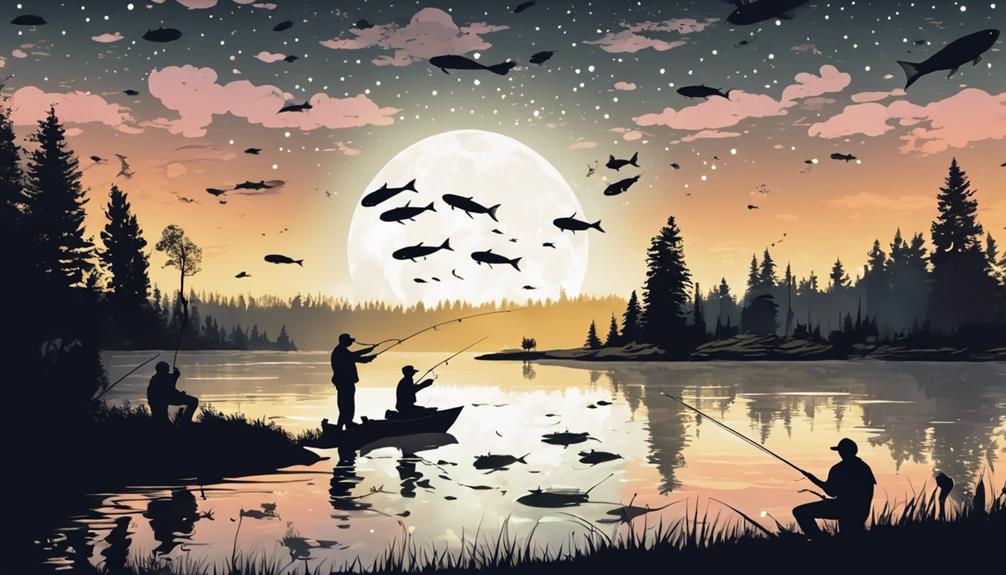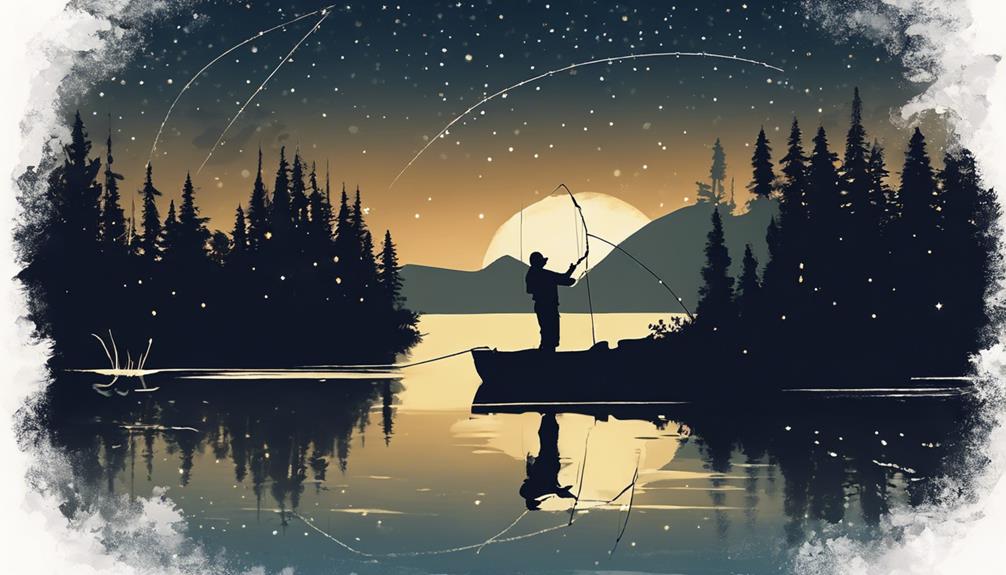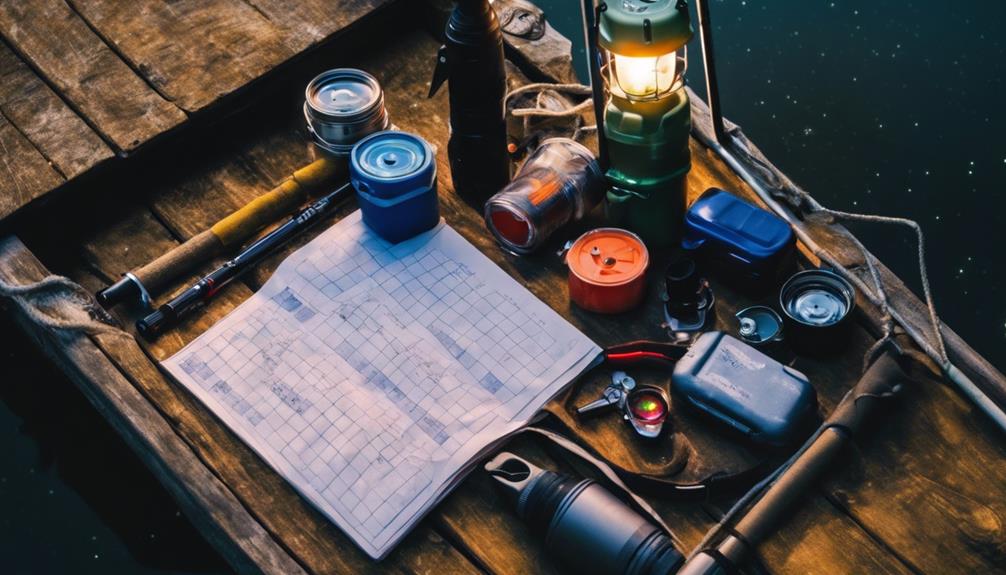When pondering night versus day fishing, consider the unique advantages and challenges each time frame presents. Night fishing offers the opportunity to target nocturnal species, experience different biodiversity, and relish a tranquil atmosphere. However, it also brings limited underwater visibility, nocturnal predators, and navigating complexities in darkness. To optimize your night fishing escapades, utilize baits with strong scents, sensitive rods, and strategic tactics. Equip yourself with lures that create vibrations, sturdy gear, and reliable lighting like headlamps. Unravel the mysteries of catch differences between day and night fishing and dive into conservation considerations for nocturnal species.
Benefits of Night Fishing
Night fishing offers anglers a unique opportunity to target nocturnal species and take advantage of their heightened feeding activity during the darkness. Moonlight fishing, in particular, can enhance the underwater activity of these nocturnal species. As the moonlight penetrates the water's surface, it creates a mesmerizing effect, illuminating the underwater world and attracting various marine organisms towards the surface. This phenomenon increases the chances of successful catches during night fishing expeditions.
When engaging in nighttime angling, you're likely to encounter a different array of species compared to daytime fishing. Nocturnal species such as catfish, walleye, and certain types of bass are more active and easier to catch during the night. These species have adapted to low light conditions and rely on their heightened senses to hunt for prey in the dark. By targeting these nocturnal species, you can diversify your fishing experience and potentially reel in some impressive catches.
Furthermore, the peaceful ambiance of night fishing can provide a serene and tranquil experience. Away from the hustle and bustle of daytime activities, you can fully immerse yourself in the sounds of nature and the gentle lapping of the water against your boat. The calmness of the night can create a meditative atmosphere, allowing you to focus solely on the task at hand – catching fish. This sense of solitude and concentration can lead to a more rewarding and fulfilling fishing excursion under the veil of darkness.
Challenges of Night Fishing
Despite the allure of nocturnal species and the peaceful ambiance, anglers face distinct challenges when engaging in fishing during the darker hours. Moonlight fishing, although romanticized for its mystical charm, can present difficulties in actually spotting fish due to the shifting shadows and limited visibility underwater. Nocturnal predators, such as catfish and walleye, are more active during the night, adding an element of thrill but also requiring heightened alertness from the angler.
Weather conditions play a crucial role in night fishing. The drop in temperature during the night can make handling equipment and bait more challenging, especially if one isn't adequately prepared with proper clothing. Additionally, sudden weather changes like fog or unexpected rain can further obscure vision and disrupt the fishing experience.
Navigating darkness is perhaps one of the most significant challenges faced by anglers at night. Without natural light sources, anglers must rely on artificial lighting, which can attract insects and other unwanted creatures. Furthermore, moving around the fishing location, especially if it's unfamiliar, becomes more hazardous in the dark. Anglers need to be cautious of their surroundings and be well-equipped with appropriate lighting and navigation tools to ensure their safety and successful fishing expedition.
Techniques for Night Fishing
When fishing at night, employing strategic techniques can significantly enhance your chances of a successful catch. One crucial aspect to consider is your bait choice. At night, fish rely more on their senses of smell and vibration detection rather than sight. Therefore, using baits with strong scents like cut bait, chicken liver, or nightcrawlers can attract fish effectively in low-light conditions. Additionally, incorporating bait that produces vibrations in the water, such as soft plastics with paddle tails or noisy topwater lures, can further entice fish to strike.
Another important factor to pay attention to is your rod sensitivity. Since visibility is reduced at night, relying on visual cues becomes challenging. As such, having a rod with heightened sensitivity is key. A sensitive rod tip can help you detect even the slightest bites or movements, giving you an edge in hooking the fish promptly. Opt for a rod that allows you to feel the subtlest tugs and nibbles, increasing your chances of a successful hookset.
Gear and Equipment for Night Fishing
Consider your gear and equipment selection carefully for optimal performance during night fishing expeditions.
When it comes to bait selection and tackle setup, using lures that create vibrations or noise can be more effective at night when visibility is limited. Choose lures with rattles or spinnerbaits that produce both visual and auditory stimulation to attract fish in low-light conditions. Additionally, consider using brightly colored or glow-in-the-dark lures to enhance visibility for both you and the fish.
In terms of tackle setup, opt for heavier lines and stronger rods to handle potentially larger catches that are more active at night. Thicker lines will also provide more control when reeling in fish, especially in the dark when precision may be compromised. Ensure that your reels are in optimal condition and spooled correctly to prevent any mishaps during nighttime fishing.
When it comes to lighting options, having a reliable headlamp is essential for visibility and safety. Choose a headlamp with adjustable brightness levels to preserve night vision while still illuminating your surroundings adequately. Additionally, consider using glow sticks or lighted bobbers to track your lines and bait in the dark waters.
Safety Tips for Night Fishing
For enhanced safety during night fishing excursions, prioritize proper lighting equipment to prevent accidents and ensure clear visibility in low-light conditions. When embarking on a night fishing trip, safety precautions are crucial to avoid mishaps.
Firstly, always carry a reliable waterproof flashlight with fresh batteries. This will help you navigate your surroundings, locate gear, and signal for help if needed. Additionally, wearing a headlamp can be beneficial as it allows for hands-free operation, enabling you to handle fishing equipment securely.
Another essential aspect of safety during night fishing is using reflective tape on your gear and clothing. This simple measure enhances your visibility to other anglers and boaters, reducing the risk of collisions. Furthermore, consider installing LED lights on your boat or kayak to increase its visibility on the water. These lights not only help others see you but also aid in locating your vessel when returning to shore.
When it comes to lighting options, choose white or green lights over red lights. White and green lights preserve your night vision better than red lights, allowing you to see clearly without compromising your ability to adjust to darkness. By following these safety precautions and selecting appropriate lighting options, you can enjoy a safe and successful night fishing experience.
Best Locations for Night Fishing
To optimize your night fishing experience, identifying the best locations with abundant fish activity is key. When considering the best locations for night fishing, it's essential to focus on areas that offer a combination of moonlit serenity and dark water depths.
One prime location for night fishing is near structures like docks, piers, or bridges. These structures provide shelter for fish during the day, and as night falls, they venture out into the surrounding waters in search of food. The shadows cast by these structures create pockets of darkness that attract fish seeking cover.
In addition, areas with submerged vegetation or underwater formations such as rocky outcrops are also excellent spots for night fishing. These features provide hiding places for baitfish, which in turn attract larger predator fish. The darkness of night gives these predatory fish the cover they need to ambush their prey effectively.
Furthermore, deep holes or channels in bodies of water are worth exploring for night fishing. Fish often seek refuge in the cooler, darker depths during the day and become more active near the surface at night. By targeting these dark water depths, you increase your chances of encountering fish actively feeding under the moonlit sky. Remember, safety should always be a top priority when night fishing, so choose your locations wisely and enjoy the thrill of fishing under the stars.
Differences in Catch Between Night and Day

When comparing the catch rates between night and day fishing, significant differences in fish behavior and feeding patterns become apparent. Catch comparison studies have shown that night fishing often yields higher success rates than day fishing. This can be attributed to the behavioral patterns and fish activity that vary between these two time periods.
During the night, many species of fish are more active in search of food. Nocturnal feeders such as catfish, walleye, and crappie tend to be more responsive to bait and lures under the cover of darkness. These fish are less wary and more willing to strike, leading to increased fishing success rates. In contrast, daytime fishing requires more patience and finesse as fish are often more cautious and selective in their feeding habits.
Furthermore, the reduced visibility at night can work to the angler's advantage. Fish rely less on sight and more on their other senses like smell, sound, and lateral lines to detect prey, making them more susceptible to well-placed baits. Understanding these fish behavioral patterns is essential for maximizing catch rates regardless of the time of day.
Conservation Considerations for Night Fishing
Considering the impact of nocturnal fishing activities on aquatic ecosystems is crucial for effective conservation management. Night fishing can lead to wildlife disturbance due to the use of artificial lights. Light pollution from fishing activities can disrupt the natural behaviors of nocturnal species, affecting their feeding and reproductive patterns. It's essential to minimize the use of bright lights and opt for red or green-colored lights that are less disruptive to aquatic life.
Resource depletion is another concern associated with night fishing. Nocturnal species have adapted to feed and reproduce during the night, and fishing during these times can lead to overexploitation of their populations. To mitigate this, implementing catch limits and size restrictions for night fishing can help sustain fish populations and maintain ecological balance.
Understanding the nocturnal habits of aquatic wildlife is crucial for effective conservation during night fishing. Many species exhibit unique behaviors during the night, such as feeding near the water's surface or spawning in specific locations. By being aware of these behaviors, anglers can minimize their impact on vulnerable species and their habitats.
Frequently Asked Questions
Can Artificial Light Scare Away Fish During Night Fishing?
Artificial light can indeed affect fish behavior during night fishing. Depending on the intensity and color of the light, it can either attract or scare away fish.
Factors like moon phases can also play a role in how fish respond to artificial light. Understanding these dynamics can greatly impact your fishing success when using artificial light as a tool to lure in your catch.
How Can Moon Phases Affect Night Fishing Success?
The lunar influence on night fishing success is significant due to its effect on fish behavior. Moon phases can impact feeding patterns and movement, affecting catch rates.
Understanding tidal patterns is crucial as they influence fish activity levels. Adjust your fishing strategy based on moon phases; for example, full moons may increase fish activity, while new moons might lead to more cautious behavior.
Are There Specific Regulations for Night Fishing in Different Areas?
When night fishing, it's crucial to be aware of specific regulations in your area. Safety measures and legal requirements vary, such as the need for proper lighting on your boat and permits for night fishing.
Carefully follow all rules to ensure a smooth and lawful fishing experience. Always check with local authorities for any restrictions or guidelines to make sure you're fishing within the law and staying safe on the water.
What Are the Effects of Temperature on Night Fishing Results?
When night fishing, temperature variations can significantly impact your results. As temperatures drop, fish tend to be more active and move closer to the surface to feed.
Warmer temperatures may lead to decreased fish activity, causing them to retreat to deeper, cooler waters. Understanding these fish behaviors in relation to temperature fluctuations can help you strategize and optimize your night fishing experience for better catches.
Can Underwater Structures Impact Night Fishing Outcomes?
When considering underwater structures in the context of night fishing outcomes, it's crucial to note their impact on underwater visibility and fish behavior.
These structures can serve as shelters for fish during the night, influencing their movement patterns and feeding habits. Moreover, they may create areas of low visibility, affecting fishing success.
Understanding how underwater structures interact with these key factors is essential for optimizing your night fishing experience.
Conclusion
In conclusion, night fishing offers unique benefits such as increased chances of catching certain species and a quieter, more peaceful environment. However, it also presents challenges such as limited visibility and potential safety concerns.
By utilizing the right techniques, gear, and safety precautions, night fishing can be a rewarding experience for anglers. Understanding the differences between night and day fishing, as well as considering conservation efforts, can help ensure a sustainable and enjoyable fishing experience for all.



